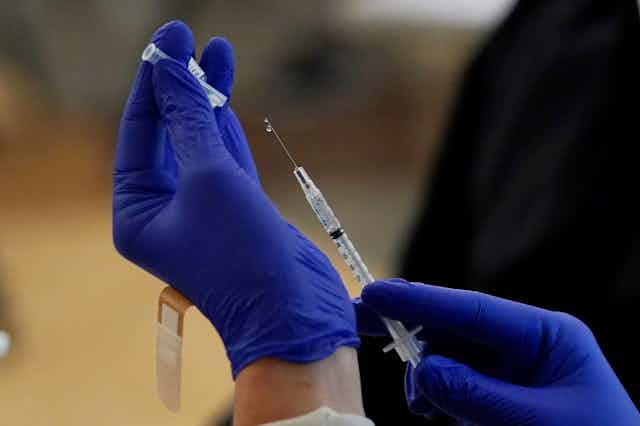By any global measure, Australia’s response to the COVID pandemic has been a spectacular success. Public health measures introduced by state, territory and federal governments, with the help of the Australian community, have significantly reduced the impact of the disease.
The response has come at significant economic and broader health costs, however. As the second wave in Victoria showed, success can be fragile. The strong measures needed to regain control of an outbreak bring unavoidable social and financial harms.
To avoid another surge in case numbers, it is crucial that we plan for the coming months as we head into 2021.
Emerging evidence suggests the first-generation vaccines currently in clinical trials have a good chance of preventing SARS-CoV-2 related illness, but they are less likely to prevent infection with the virus altogether. This means it is unlikely current vaccines will adequately suppress viral transmission.
This means there’s not yet a “silver bullet” that can return Australia and the world to pre-COVID normality. Instead, we anticipate a scenario in which vaccines, antiviral therapies and other tools that become available will help reduce COVID-associated hospitalisation and deaths.
Suite of measures
To be optimally effective, vaccines must be considered as part of a wider suite of measures. The advent of vaccines does not mean we can now weaken, much less abandon, the other public health methods developed and practised in their absence.
In a new review of likely next developments, published by the Australian Academy of Health and Medical Sciences, we found that for the foreseeable future, national control of the pandemic will need to be driven by:
- ongoing implementation of comprehensive public health measures. High levels of swab testing for the SARS-CoV-2 virus coupled with contact tracing, isolation and quarantine will be crucial. This should be set alongside physical distancing, enforced if needed, the judicious use of face masks, and effective controls at international borders. The communication and delivery of these approaches increasingly needs take into account differing socio-economic backgrounds, cultural diversity, and rural or suburban locations. To be most effective, they should be developed in consultation with these respective communities.

- optimal rollout of effective and safe vaccines, treatments and other interventions as they become available, including improved antigen testing to provide rapid options for active case detection
effective prevention and management of the long-term health issues arising from the pandemic, especially mental ill-health and the effects of “long COVID”. Prevention and treatment programs must especially target people who are most vulnerable to COVID, including health professionals, older people, those in low socioeconomic groups and our first nations peoples
contributing to the global management of the pandemic, particularly by supporting our neighbours in the Asia-Pacific region
sustained and enhanced support for research and innovation to deliver the knowledge and tools required to tackle the pandemic – even when case numbers are low.
The top priorities
In our review, we identify four areas for priority attention, subdivided into 15 specific actions, to ensure Australia is equipped to build a system that is robust and yet flexible enough to continue its successful management of the pandemic – at home and abroad.
We need to create effective systems and capabilities to develop, manufacture and distribute vaccines, treatments and diagnostic tests.
We must monitor the health impacts of COVID within Australia, and the acceptability, safety, efficacy and uptake of vaccines, treatments and other interventions.
We have to enable ethical and equitable rollout of vaccines, treatments and other interventions.
And finally, we must be able to respond to the evolution of the pandemic through a readiness to modify public health measures appropriately. Frequent hand-washing and cough etiquette must be sustained. Strategies such as hotel quarantine for overseas travellers, and tightening of restrictions during periods of community COVID transmission, are major tools that have shaped Australia’s enviable achievement to date and will doubtless be needed again. This might mean periodic resumptions of strong social distancing, limits on gatherings (particularly indoors), safe use of public transport, wearing of masks, and isolation.
Read more: We modelled how a COVID vaccine roll-out would work. Here's what we found
Australia’s capacity to deliver effective public health programs, together with our world-class research and innovation sector, mean we are well placed to execute this agenda.
Doing so successfully will bring additional, longer-term benefits, through enhancing our ability to respond to future pandemics.

